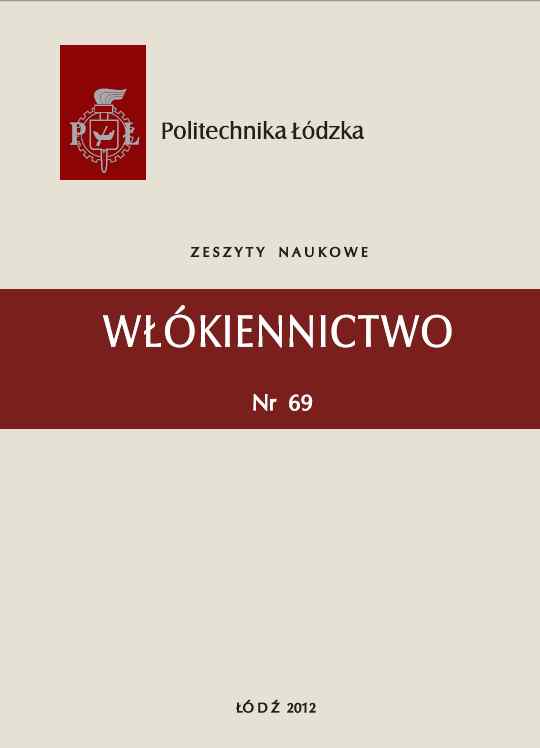Abstract
The work concerns the study of the structure (the interaction between fibers of both feed yarns) of the component yarns made by highly efficient air interlacing technique. The component yarns were made of two feed yarns: continuous fiber yarn and staple fiber yarn. In next stage a plan of experiment was done which considered information on component yarns ingredients and the change of technological parameters of interlacing process.
Then 45 variants of interlaced component yarns were made. Such yarns were made in three assortment groups, which contain three types of feed cotton yarns (carded, combed and rotor yarn) joined with polyester continuous yarn. The new yarns were examined in terms of their basic physical and quality features. The metrological tests results were analyzed in order to find dependencies between feed yarns structure and parameters, the parameters of the technological process of yarn connecting and the structure parameters of final interlaced component yarns.
Finally tests were performed on using such yarns in the flat textiles production (a virtual visualization of appearance of the flat textiles – knitted and woven fabrics was prepared and the real knitted fabric from selected component yarns was made.
The test results open the possibility of creating structure and parameters of unique component yarns, which were made by air interlacing technique. The proper selection of the basic technological parameters and types of feed yarn give possibility of obtaining yarns of required properties so these properties are fully used keeping the optimum processing efficiency.
References
Jabłonski W., Jackowski T.: Nowoczesne systemy przędzenia bazą innowacyjności w procesach wytwarzania przędz, Wyd. Beskidzki Instytut Tekstylny, Bielsko-Biała 2001.
Ankudowicz W., Dopierała H.: Sczepianie pneumatyczne w wytwarzaniu przędz filamentowo-staplowych, Przegląd Włókienniczy nr 1/2005.
Sachova N., Usenko V.: Opracowanie technologii dwuskładnikowych przędz teksturowanych na jednoprocesowych maszynach różnego typu, Przegląd Włókienniczy nr 7/1985.
Priemsch W., Jansen P.-B.: State–of–the–Art Air Interlacing Technology for Filament Yarns, Journal of Industrial Textiles, Vol. 34, No. 3/2005.
Engelhart A.: SAURER RAPORT „Fiber Consumption Surged in 2004“, International Fiber Journal No. 6/2005.
Schwartz E., Lacher L. (Heberlein Fiber Technology Inc.): Air covering – a process with great potential, Presentation during the Elasthan Colloquium, Denkendorf, Germany 2001.
Bosch F. (Heberlein Fiber Technology Inc.): Polyester Micro and Super Micro Filament Yarns – a Megatrend, Asian Textile Business, November 2005.
Scherpt H.-D., Marc A. Zenses.: Advanced Air Jets to Meet Higher Performance Yarn Reguirements, International Fiber Journal, February 2004.
Weinsdoerfer H.: Improved Consistency in Flat Yarn Interlacing, International Fiber Journal, December 2001.
Scherpt H.-D., Mack A., Marc A. Zenses.: Interlacing technology for the manufacturing of BCF carpet yarns, Man Made Fiber, Year Book 2006.
Muller-Probandt S.: Manufacturing process of atmofil DSE yarns, Man Made Fiber, Year Book 2005.
Kryteria doboru parametrów procesu sczepiania przy zastosowaniu przedz poliuretanowych, E. Mielicka, Praca doktorska, Politechnika Łódzka 1999.
Pneumatyczny sposób tworzenia przędz łączonych staplowo-filamentowych, projekt badawczy nr 4T08E08224; 4.2003-12.2004, kierownik: W. Ankudowicz (Instytut Włókiennictwa).
Opracowanie oraz optymalizacja nowej generacji dysz pneumatycznych do łączenia przędz staplowych i staplowo-filamentowych, projekt badawczy nr 3T08E03630; 07.2006-06.2008, kierownik: W. Ankudowicz, H. Dopierała (Instytut Włókiennictwa).
Kształtowanie struktury i właściwości wybranych przędz komponentowych łączonych pneumatycznie, P. Swaczyna, Praca doktorska Politechnika Łódzka 2012.

